
|   |

|   |
 e-mail: leelakaverivenkat@gmail.com Remembering Rohini Bhate Photos courtesy: Nrityabharati November 2, 2022 Coinciding with the year of India's Amrit Mahotsav, Nrityabharati Kathak Dance Academy established by Kathak legend Rohini Bhate (1924-2008) at Pune in the year 1947, also observed its seventy fifth year of existence. And what more fitting way of celebrating the occasion could there be than dedicating it to the founder Guru, by going down memory lane through a film Amrutmanthan, recapturing her enormous multi-dimensional work, coupled with performances of her compositions, by senior students of the Academy. The three -day Delhi projection, starting with a two-day event at the Habitat, signed off with a screening of the film at SNA's Meghdoot theatre. 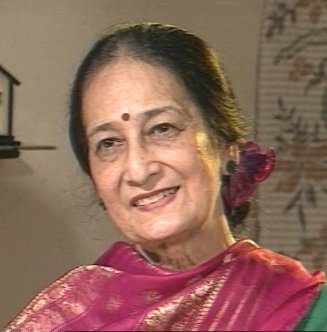  Rohini Bhate The start, at Stein auditorium with a smattering of persons attending, reminded me of Shakespeare's words ...the evil that men do lives after them/the god is oft interred with their bones. Surely an artiste of the caliber of Rohini Bhate, (conferred the highest recognitions like Kalidas Sammaan, Maharashtra Gaurav Puraskar and Fellow of the SNA) deserved a better homage! Barring a scattering of about half a dozen, Kathak Kendra dancers were conspicuously absent. Recollecting clearly the picture of Rohini Bhate's interventions in the many seminars held at the Kathak Kendra, with the likes of Pandit Birju Maharaj attentively taking in, what an artist known to be as steeped in research into ancient texts as in the dance practice, had to say, one wondered if the youngsters of today were so self- absorbed that they felt no need, even to take in what legends had to contribute. Unfortunately, attendance did not show great improvement even at the SNA for the film screening. 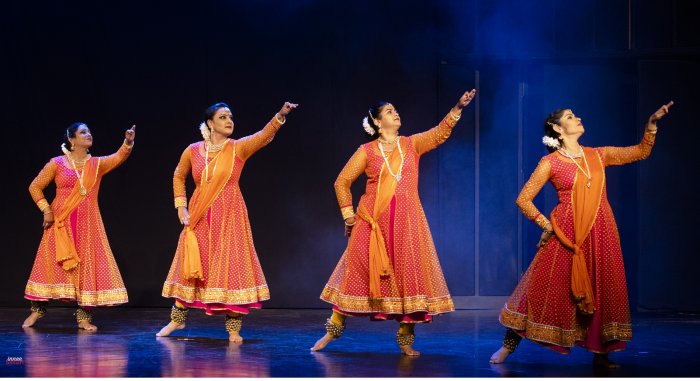 Traditional Roop Kathak A complete artist who combined high formal education with a prodigious intellect along with exceptional artistic abilities, Rohini Bhate's works sported excellence in every sphere. With elegance covering every aspect of her work, Rohini Bhate's senior student Neelima Adhye's planning of the event, wisely, did not go in for quantity, as for a few representative productions presented by the students, along with participants from other dances and styles sharing the stage. This was in keeping with Rohini's open, interactive attitude, with other artistes and art forms - her own works seasoned by a flavor which went beyond formal, technical efficiency. The evening began with invocation to Lord Ganesh Gananatha Gaurisuta... set to tala in 7 ½ matras (Neel), which students performed to perfection. With an uncanny feel for time measurement in a tala, Rohini Bhate seemed to have an inner feel for the cadence of a tala, not dependent on, and beyond counting of matras. This came from an innate musicality - having learnt music from reputed masters like Vasant Rao Deshpande and Keshav Rao Bhole and even the Benares gharana tablist Arvind Kumar Azad who worked with her in several compositions for years, felt that this feel for fractional time, was instinctive. He admitted that even though he had worked on thekas of talas with her, her laya ability was inborn. Guru Mohanrao Kallianpurkar with whom she trained for fifteen years (after having started under Sohanlal, she had trained for over ten years under the Kathak maestro Lachhu Maharaj), also a rhythm maestro, with his special feel for talas in fractional matras, found in Rohini a kindred student. 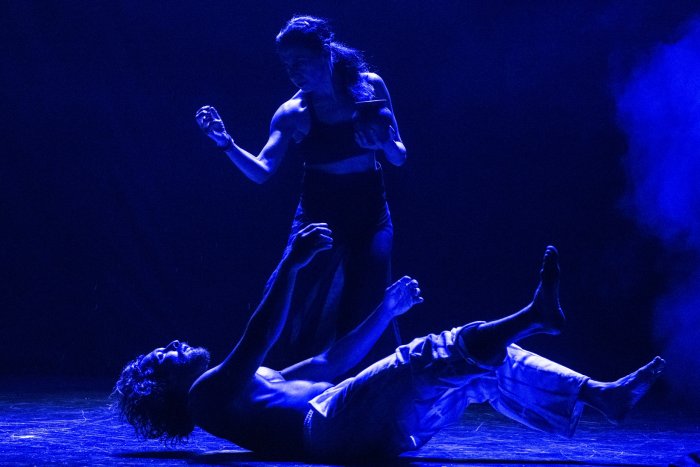 Terence Lewis and Mahrukh Dumasia The sweep of Rohini Bhate's mind was seen in the fact that she could connect Kathak with ancient Sanskrit texts as easily as she could show how the dance technique could be harnessed for depicting non-traditional themes outside the routine repertoire. It was in keeping with this open attitude that the opening day's Multidisciplinary Expressions on 'The Five Elements' saw a Modern Dance Expression by Terence Lewis and Mahrukh Dumasia who presented Kalash (the pot) which denotes prosperity, in what was an interaction between Earth and Water. While both are strong dancers, this critic found an unmitigated attitude of aggression in the performance, lacking in softness and musicality. Even while Earth and Water may have worked at cross purposes often, surely Water which sustains life and Earth which provides living space, could not be without their moments of tenderness and togetherness. Along with the one powerful douche from the pot filled with water, to revive Terence as struggling Earth, one felt a softness / belligerence contrast, would have been more fitting. 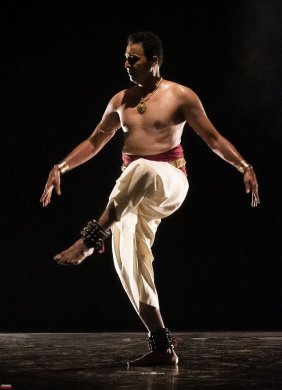 Vaibhav Arekar A theme like the Elements, which have no form, ultimately demands a dance statement in abstraction, and to suggest formlessness through a dancer's body which has a compulsive presence, and a dance technique which has its own form, is a challenge. How does one capture the idea of Aakash as a limitless void, represented in sculpture and dance, by the dancing figure of Nataraja, particularly in Bharatanatyam? What is the 'Chidambara rahasyam' (the secret of Chidambaram) one speaks of, with regard to the famous temple of Shiva? If the figure of Nataraja is a metaphor for the moving universe, how does one convey the idea of Muthuswamy Dikshitar's sthalalinga composition in Kedaram "Ananda nadana prakasham" on the element of Aakash? Dancer Vaibhav Arekar demonstrated how his tall frame performing in the Bharatanatyam form could be wished away in an interpretation of Muthuswamy Dikshitar's song, when the inner consciousness gets seeped in a realization of inner space, where the ultimate is nothingness. After Alarippu, Vaibhav's interpretation of the kriti, with Sushant Jadav's magical lighting making the dancer's form get slowly sucked into the void of darkness, left many in the audience teary eyed. Suffice it to say, that it is once in a way that one comes across a performance of this caliber. True to Rohini Bhate's interactions with all art forms, in a brief poetry reading session, Ashok Vajpeyi, an admirer of Rohini's ability for dialogue across disciplines, read out his sensitive poems on the five elements. The first evening ended with traditional Kathak presented by the Nrityabharati troupe, and one appreciated not just the impeccable performance, but the taste in costuming which spoke of muted elegance, with no loudness of colour or ornamentation. 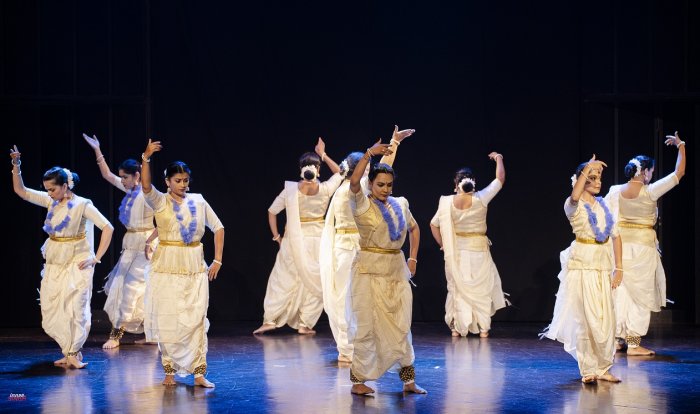 Tanmatra (Akash) 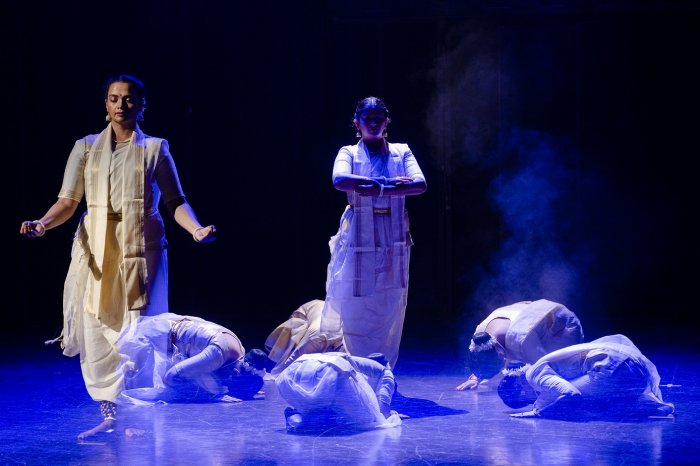 Tanmatra (Avahan) The second evening's fare comprised a revived version after twenty five years, of Rohini Bhate's creation woven round Tanmatra, the emergence of the five elements in their subtle forms. Based on lyrics from the Upanishads, one of the highlights was Rohini Bhate's own exquisitely composed music - and one saw how she had this tremendous feel for sound - in music, in 'laya', in padhant - jointly evoking a mood, to convey a feel of moving air, of touch, of flowing water, of warm energetic fire, of earth burnished with the seasons. Bharatanatyam dancer Kalanidhi Narayanan rightly observed that Rohini Bhate imparted through rhythm an appearance of substance to the unsubstantial. Costumes, as usual, were very tasteful involving just changing the dupattas in different suggestive colours, draped over an off-white and gold ghagra getup, for each element. The production was rightly referred to as a shabda, Yagna Karma, evocative, amidst all the movement, of expansive tranquility. And how well the dancers executed the item - in perfect group discipline!  Ashok Vajpeyi speaking at the panel discussion This was followed by a discussion among personalities who matter in the field of dance, with Ashok Vajpeyi's observation that Kathak which lived in practice and performance alone, without any documented theory, was given a feel of its connections to the Sanskritic past, by Rohini Bhate with her combined learning along with proficiency in the practice of the dance. She authored a Hindi book based on Nandikeswara's Abhinaya Darpana. Very appreciative of her ability to interact with other art forms, Ashok Vajpeyi, when he was presiding over cultural administration, had tried earnestly to promote and encourage this interactive, coming together of art forms, but had failed - with people in the dance field insularly lost only in their own little world of dance events. Manjari Sinha corroborated the speaker's observation by mentioning how his attempt to involve all art forms in an event he had held at the Lalit Kala Akademi when in charge, had created an enthusiastic response for the moment. Vaibhav Arekar, replying to Prerana Shrimali's query about how he had used a language of form to convey formlessness, spoke of how dancers often fall into the trap of being less than honest with themselves when on the stage, and he was glad to have a person like Sushant Jadav who was brutally blunt about Vaibhav's stage appearances - telling him in no uncertain words whenever he had tried to fool the audience by pretending something he had not felt. Deep internalization was needed for making both dancer's form and the dance form get subsumed in the state-of-being evoked. After much cogitation he had arrived at a way of interpreting the concept of Shiva as the limitless expanse of Aakash. He had done his best and the work of Sushant's light effects, was a great contributing factor. The other dancer on the panel Terence, questioned on the aggressive tone of his work spoke of his concept of Earth and Water being constantly at war with each other. Ultimately, it is a question of how the concept is worked out in the mind of the creator. He was however very open to the idea of trying out an approach where the two elements have moments where one does not always try to overpower the other. Neelima Adhye touched on the many sided talents of her Guru and spoke of her sensitivity to music. Manjari Sinha referred in brief to the ragas used in Tanmatra to convey the kind of dance movement associated with each element. Rohini Bhate was not afraid to take risks, said Prerana Shrimali who also admired how she courageously tried out new themes - and came out successful. Ultimately, her dance was guided by a purpose, and was never meant to be just an ornamentation. Not for her virtuosity for its own sake! 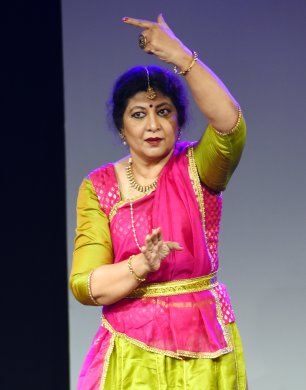 Samasyapurti Amrutmanthan, the film is a marathon effort to capture an essence of the endless creative output of Rohini Bhate. While a two and a half hour film seems overlong, to edit seventy five years of creative output into anything less, one realizes, would require herculean effort. The best parts are snippets showing Rohini Bhate herself performing. The poise and dignity of bearing, the quietly elegant costuming, apart from the performances, are what one will not be able to see anywhere else. Her nritta brilliance apart, there are the interesting abhinaya sections - one even woven round vartamanagupt nayika based on a Vidyapati composition. One cannot help wondering if treating a heroine of this nature (very far from her preferences shown in her usual abhinaya depictions) had come out of her work with Bharatanatyam expert Kalanidhi Narayanan, whose student Jamuna Krishnan's special research was on Vidyapati poetry, and his nayikas have a flamboyant boldness, not very common in the Padams and Javalis usually performed today by Bharatanatyam dancers. Rohini's other abhinaya item Samasyapurti was based on Raja Birbal's poetry "Rata samayrasa keli kiyo." 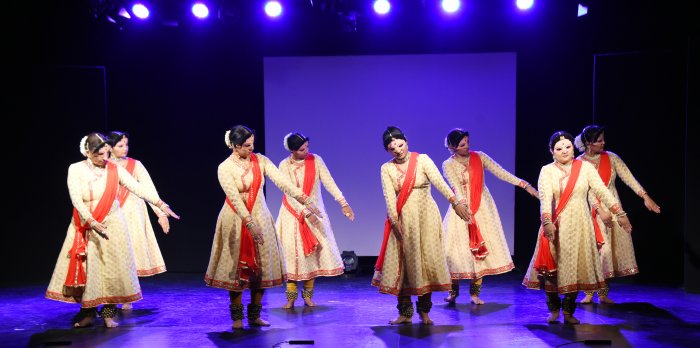 Kathputli Apart from the Dasavatar based on the Gita Govind verses sung by Rohini herself in her own music, and Shankara's hymns like Champeya Gauranga and compositions like Shive Sringaradhre visualizing Shiva as pure Creator, one saw works on Krishna in a composition like Brindavane dhama and Kadambasukha, and there were several compositions based on Marathi prose. Even in her interpretation of Bindadin Maharaj's lakshana geeta 'Nirakat Dhang' and compositions based on technical aspects of Kathak, like in the production Shatarangini based on time honoured Kathak repertoire, one invariably detects an original touch. There was the 11 ½ matra Soha tala. One even sees a clip showing students of Nrityabharati performing the dance of the Kamboli Tribe, because Rohini Bhate held the view that classical dancers by doing folk dances characterized by uninhibited abandon, acquired and imparted to their own performances a certain additional quality of vibrancy. Rohini Bhate's sense of humour can be glimpsed in work based on Bhavani Shankar Misra's poems - the satire Mein Udaas Hoon and Kathputli. As the unseen narrator, Neelima, through the briefest of introductions for each of the film snippets, strings the various parts together. In the final analysis, she and her team, notwithstanding the disappointing response, can feel that they have done their guru proud.  Writing on the dance scene for the last forty years, Leela Venkataraman's incisive comments on performances of all dance forms, participation in dance discussions both in India and abroad, and as a regular contributor to Hindu Friday Review, journals like Sruti and Nartanam, makes her voice respected for its balanced critiquing. She is the author of several books like Indian Classical dance: Tradition in Transition, Classical Dance in India and Indian Classical dance: The Renaissance and Beyond. Post your comments Pl provide your name and email id along with your comment. All appropriate comments posted with name and email id in the blog will also be featured in the site. |